Genesis 11:1–9 recounts a mythic narrative about a group of people who settled in Mesopotamia and constructed a city and a tower, only to have God confound their language and scatter them throughout the known world.
Does this narrative recount an actual historical event? If so, when did it occur, and can archeology tell us more about what happened?
The Jaredite Record as a Second Witness
Most biblical scholars take one of two approaches to this story:
- The Tower of Babel story came into being when the Jews were carried captive to Babylon in 586 B.C. There, they saw the city’s mighty ziggurat, the E-temen-anki, and were inspired to tell a story about its haughty builders and their fate.
- The Tower of Babel story was a mythic tale that arose in pre-exilic Israel (1100–600 B.C.) to explain the origin of multiple languages. It took inspiration from similar tales in neighboring cultures and from accounts of ziggurats in far-off Babylonia.
Both approaches conclude that the story is entirely fictional.
[Pro tip: hover over links and footnotes to see the associated text.]
However, as Latter-day Saints, we have the Book of Mormon as a second witness. This book contains an account of the same event preserved through a record entirely separate from the Bible: the record maintained by “the people of Jared, who were scattered at the time the Lord confounded the language of the people, when they were building a tower to get to heaven” (title page of the Book of Mormon).
References to “the tower” from which the Jaredites came occur in Omni 1:20–22, Mosiah 28:17, Helaman 6:28, and Ether 1:33–38. The reference in Ether provides the most detail:
Jared came forth with his brother and their families, with some others and their families, from the great tower, at the time the Lord confounded the language of the people, and swore in his wrath that they should be scattered upon all the face of the earth; and according to the word of the Lord the people were scattered.
Thus the Jaredite record and the Israelite record agree on three points that form the core of the historical event: (1) After the Flood of Noah, a group of people built a tower. (2) The Lord confounded their language. (3) The Lord scattered them.
Dating the City and Tower
When did this event occur? Chronologies based on literal readings of Genesis date the flood around 2350 B.C. and the birth of Abraham 292 years afterward, placing Babel in that window. However, the Bible underwent a long and complicated process of authorship, editing, and transmission, where little details like dates could easily become corrupted and genealogical lines could be simplified. For various reasons—which I spell out in pages 7–11 of this paper I wrote in college, and which principally result from my reconstruction of Jaredite chronology—I date the scattering of Babel to somewhere between 2600 and 3100 B.C.
Is there an archeological setting that matches the event described in Genesis and Ether? There might be one in the Middle and Late Uruk Period (3500–3000 B.C.) in Mesopotamia.1
What Was Uruk?
From about 9000 B.C. to 3500 B.C., humans in Mesopotamia (and the rest of the world) lived either in pastoral-nomadic tribes or in small agricultural villages, eking out a living with very limited farming technology. Gradually, as humans got better at growing food, villages became larger, with a few small local centers arising: the largest discovered so far, Tell Brak in northern Mesopotamia (modern-day eastern Syria), only occupied 320 acres (half a square mile).
Then, around 3500 B.C., something changed in southern Mesopotamia (modern-day Iraq). New farming technologies and greater cooperation in irrigation projects produced higher yields of food, allowing a larger portion of society to engage in specialized crafts. Those craftsmen needed a centralized place to live and exchange their wares. Thus was born the first true city in history: Uruk.2 Uruk had been a modest settlement in southern Mesopotamia for quite some time, but from 3500 to 3100 B.C. it grew exponentially, until it occupied at least 620 acres: twice the size of any comparable settlement of that time. In addition, a hierarchy of towns, villages, and hamlets grew up around it, making Uruk a regional center of trade.
Some scholars think that the sudden rise in Uruk’s population can only be accounted for by migrants from the east or north. Marc Van de Mieroop, a professor of ancient history at Columbia University, writes:
The number of people who resided in [Uruk]’s orbit was so great that they could not have come from Babylonia alone. Some seem to have migrated from western Iran and northern Mesopotamia to the south.3
With the growth in population came a rise in inequality. House sizes and grave goods in Uruk show evidence of large disparities of wealth and a complex social hierarchy. Controlling this hierarchy was a new social institution: the temple state.
Uruk’s Temple State
Uruk’s economy was structured around its temple, which controlled vast swaths of farmland, owned scores of temple dependents who worked the land or created other goods, and oversaw the offerings to Uruk’s gods. Van de Mieroop writes:
The monumental temple, the house of the god and built by the community, was the central institution that made the system work. Its buildings presented an impressive sight and a visual focus for the surroundings of Uruk, which was located in an extremely flat region. [The temple] was a focal point for all, . . . and through its collection of tribute drew the entire region together.4
At the center of Uruk, two large temple complexes were built during the late Uruk period: The Eanna temple, or “House of Heaven,” built to the goddess Inanna, and the White Temple, built to the sky god Anu. The Eanna complex included several monumental structures 150 by 240 feet in size, dwarfing anything mankind had built up to that point. The White Temple of Anu was constructed atop an artificial platform—a mound of hauled and compacted earth—that reached 42 feet in height. Van De Mieroop comments on the magnitude of these projects:
[The temple structures’] monumentality tells us much about society at Uruk. They could only have been built by a large labor-force that required organization and leadership. Archaeologists have calculated that for each complex some 15,000 laborers worked ten hours a day for five years. Although religious sentiments may have partly inspired them to do so, some type of coercion was probably involved as well. While such enterprises could only succeed in large communities, they also strengthened the social ties between the people who were themselves involved or had relatives who were. They generated a common sense of purpose.5
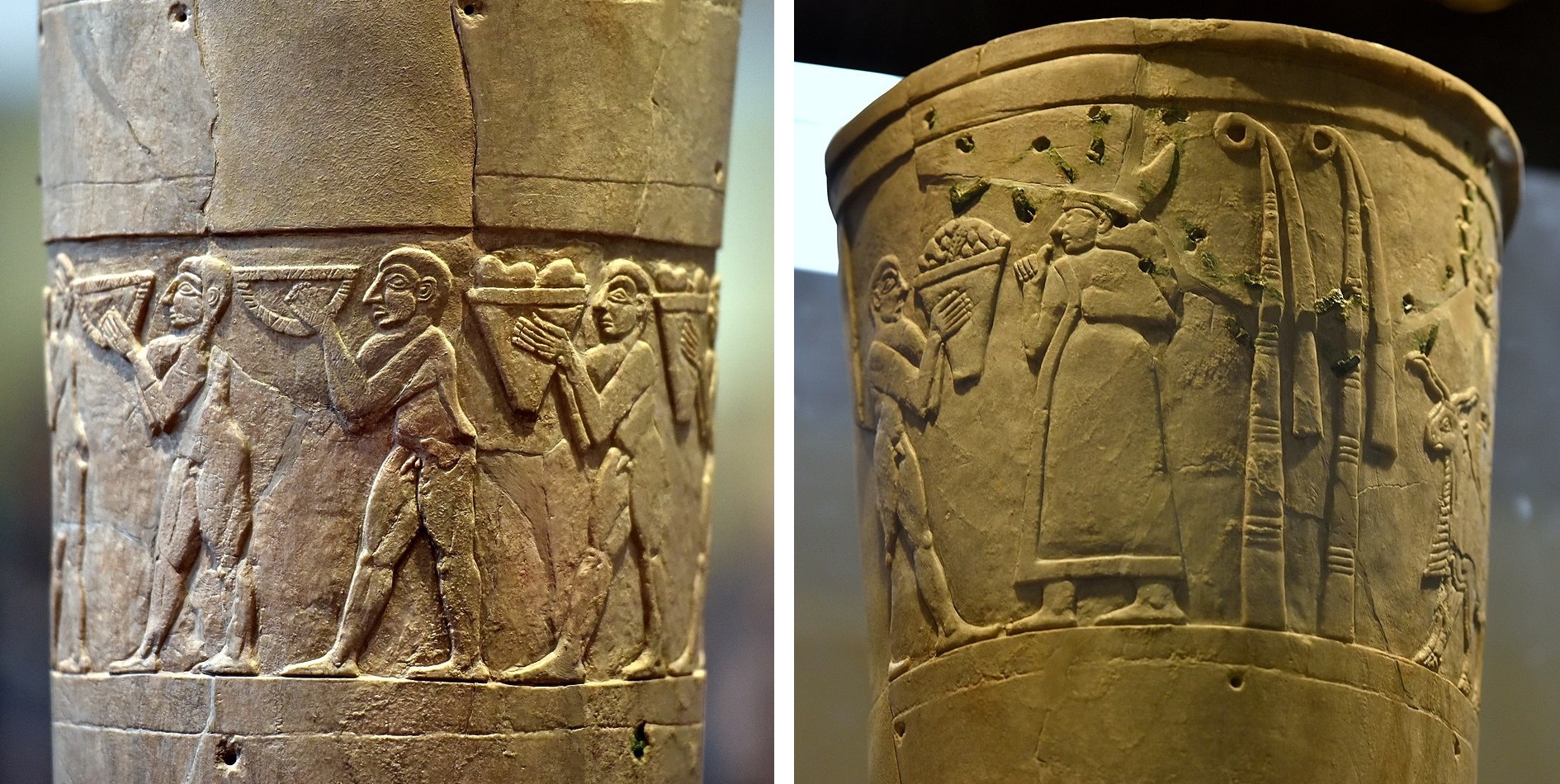
The Warka Vase from Uruk depicts temple servants (left) presenting agricultural products as offerings to the goddess Inanna (right). (Photos of top and middle registers by Osama Shukir Muhammed Amin, CC BY-SA 4.0, via Wikimedia Commons.)
Besides the large construction projects at home, Uruk’s culture and influence—indicated by its distinctive material remains, most notably a ubiquitous style of mass-produced bowl—spread throughout the ancient Near East, to sites in Northern Mesopotamia, Syria, Iran, and as far away as western Pakistan. The exact nature of this spread is uncertain, whether it was mercantile colonization, imperial expansion, or cultural influence. But in any case, Uruk’s cultural if not political reach was widespread and profound.
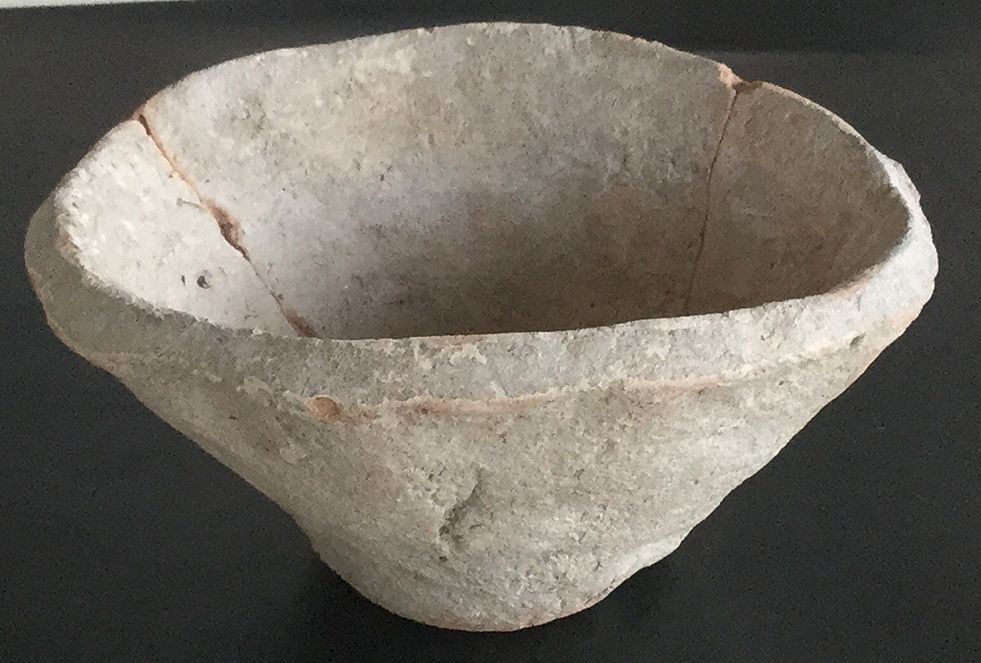
Hundreds of these distinctive “beveled-rimmed bowls,” first attested in Uruk, have been found at sites throughout the Near East, evidence of Uruk’s far-reaching cultural and economic influence. (Photo by Schauschgamuwa, CC BY-SA 4.0, via Wikimedia Commons.)
Uruk’s Collapse
What happened to Uruk? At the end of the fourth millennium, between 3100 and 3000 B.C. (just as it was on the verge of inventing cuneiform, the world’s first writing system), Uruk mysteriously collapsed. Contact with far-flung locations was cut off. Local societies reverted to their earlier cultures and formed independent states. The White Temple of Anu was abandoned, and the monumental buildings that formed the Eanna complex were leveled and eventually replaced with new structures. The city of Uruk continued to be substantially large, but other cities arose elsewhere in Mesopotamia, signaling a cessation of Uruk’s centralized power. Van De Mieroop sums up the changes: “There was thus a reorganization of society in southern Mesopotamia into more and similar-scale centers.”6
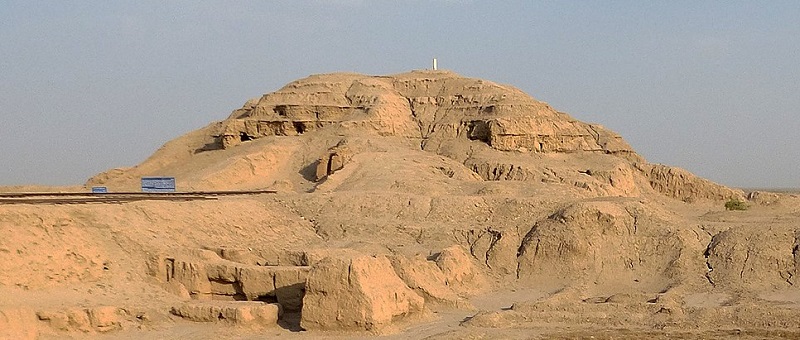
All that remains of the White Temple in Uruk is this large mound of half-eroded mud brick, still towering over the desert landscape around it as a witness to what Uruk once was over five thousand years ago. (Photo by tobeytravels, CC BY-SA 2.0, via Wikimedia Commons.)
Uruk and the Story of Babel
The parallels between Uruk and the biblical story of Babel are many:
| Uruk was located in southern Mesopotamia | The “plain of Shinar” (Genesis 11:2) is the Hebrew name for Mesopotamia. |
| Uruk’s population likely included immigrants from the north or east | “As they journeyed from the east,” Genesis 11:2. |
| Uruk’s structures were made primarily of mud brick, many of them baked hard. | “Go to, let us make brick and burn them thoroughly. And they had brick for stone,” Genesis 11:3. |
| Uruk was the first major city in world history, the first time that thousands of people congregated in one place. | “Go to, let us build us a city,” Genesis 11:4. |
| The people in Uruk and the surrounding regions displayed an unprecedented level of cooperation, commerce, and regional influence, with far-flung contact to locations throughout the Near East. | “The whole earth was of one language, and of one speech,” Genesis 11:1. |
| Uruk was the site of the first true monumental structures, the first manmade buildings to reach a height of several stories. | “Let us build . . . a tower, whose top may reach unto heaven,” Genesis 11:4.
An alternate translation is “whose top is in the sky,” meaning a tall structure. The Hebrew word for “tower” here (migdol) can denote not just a tall, free-standing tower, but also a stronghold, a fortified part of a city wall, or an elevated stage. |
| Uruk’s monumental buildings were religious centers, the places of ritual connection between the people and the divine. One was dedicated to the sky god; another was called “the house of heaven.” | “Let us build . . . a tower, whose top may reach unto heaven,” Genesis 11:4.
“The people [were building] a tower sufficiently high that they might get to heaven,” Helaman 6:28. |
| These temples served as focal points uniting the people in a common cause, as well as institutions of social and economic stability. | “Let us make us a name, lest we be scattered abroad upon the face of the whole earth,” Genesis 11:4. |
| Just when the people in Uruk were achieving unparalleled advances in technology, architecture, and economic sophistication, their social order collapsed in a matter of decades. Long-distance cultural uniformity ceased, rival regional powers arose nearby, and the building projects at Uruk halted. | “The Lord scattered them abroad from thence upon the face of all the earth: and they left off to build the city,” Genesis 11:8. |
| Mesopotamia later was known as Babylonia, after the nearby city of Babylon (“Babili” in Akkadian, “Babel” in Hebrew). | “Therefore is the name of it called Babel,” Genesis 11:9.
The Jaredite references never use the name “Babel,” suggesting that this place-name was assigned to the story later, during its Israelite transmission. |
Can the Babel narrative fit other time periods or archeological settings? Certainly. There were several other periods of centralization and decentralization in Mesopotamia in the two millennia after the Uruk period, and several ziggurats that reached a much larger size than the buildings at Uruk. But Uruk stands out as the first instance of urban society, the first emergence of large-scale architecture, and the most dramatic instance of sudden, inexplicable collapse. The parallels are striking.
Conclusion
By piecing together data from the Bible, the Book of Mormon, and archaeology, we can reconstruct the following historical event:
In the second half of the fourth millennium B.C. (3500–3100 B.C.), a group of the descendants of Noah congregated in unprecedented numbers in southern Mesopotamia. There they built the world’s first major city, established a widespread cultural hegemony, and pioneered the construction of monumental buildings. Their ambitions were breathtaking: reach heaven by gathering themselves into a united people, constructing a temple to serve as a ritual gate between heaven and earth, and establishing a name for themselves. All this they would do with their own ingenuity. But Jehovah brought all their ambitions to naught. Punishing their arrogance, he confounded their language, halted their building projects, and scattered them throughout the Near East.
Ultimately, whether the events it foretells trace back to Uruk or to another period, the value of the Babel narrative is in its theological warnings: First, obey God. Do things according to His pattern. Seek to obtain heaven according to His conditions. Build a temple on His terms. Receive a name at His hand. Second, avoid arrogance. Any plan not sanctioned by God is a plan of men, and any plan of men can be stopped at a moment’s notice by God, to be left unfinished and ridiculed for the rest of time.
The builders of Babel can easily represent ourselves. Do we strive to get to heaven on our own terms? Do we expend our efforts on ambitious worldly projects that are not sanctioned by God? Do we seek to be known by any name other than the name of Christ? If we do any of these things, we are liable to be confounded and scattered in mortality and beyond. And, if we do not change, we will not be known by the name of Christ at the last day, for we shall be known by the name of Babel, or the world.
Summary
Most modern scholars relegate the Tower of Babel story to the realm of myth. The Jaredite record from the Book of Mormon, however, provides a second witness to the historical event behind the biblical story.
The story of Babel has many striking parallels with the Uruk Period (3500 B.C. to 3100 B.C.) in southern Mesopotamia, where a group of people congregated together to build the world’s first urban center and the world’s first monumental buildings. Uruk’s economy and society were dominated (and united) by the institution of the temple. The Uruk civilization experienced an as-yet-unexplained collapse around 3100–3000 B.C.
1. I arrived at this idea on my own while in college, but I am not the first to propose it. See, for example, Steve Reimer, “The Tower of Babel: An Archaeologically Informed Reinterpretation,” Direction, Fall 1996, Vol. 25.2, 64–72. As far as I can tell, however, the possible connection between Babel and Uruk is not well-known and is omitted in most discussions of Babel’s historical context. This is likely because non-fundamentalist scholars treat the Babel story as a non-historical myth, while fundamentalist scholars date Babel too late for it to overlap Uruk’s chronology.
2. The information about the Uruk Period in this article is drawn principally from Marc Van De Mieroop, A History of the Ancient Near East, ca. 3000–323 B.C. 3rd ed. (Hoboken, NJ: John Wiley & Sons, 2016.
3. Marc Van De Mieroop, A History of the Ancient Near East (Malden, MA: Blackwell, 2016), 24.
4. Van De Mieroop, 28.
5. Van De Mieroop, 26.
6. Van De Mieroop, 42.
Banner image by tobeytravels, CC BY-SA 2.0, via Wikimedia Commons.
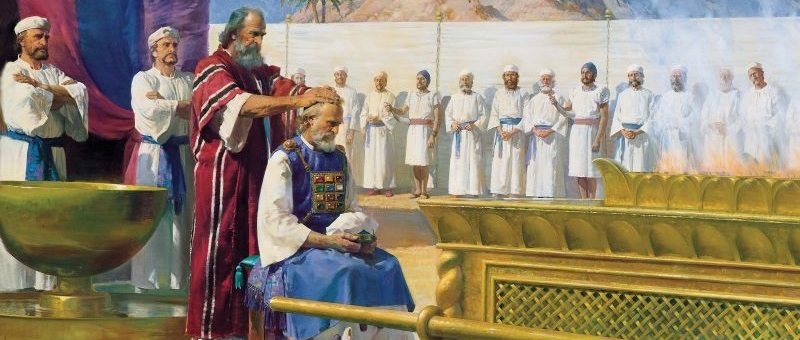
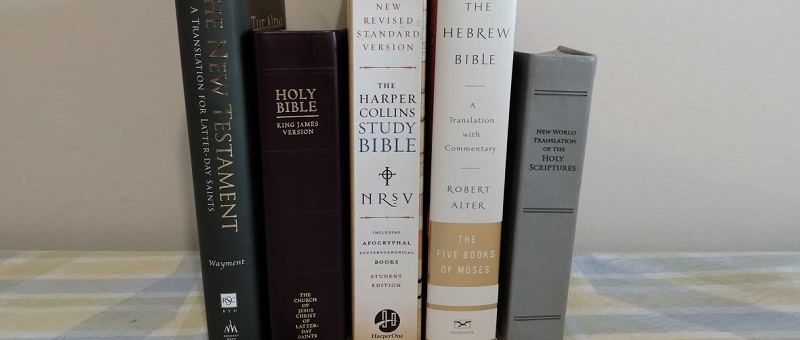
I found your research on Uruk and its possible connection to the Tower of Babel fascinating! That whole region, which we now identify as the countries of Iraq, Syria, etc., has such amazing archeological treasures and history. It’s too bad that decades (and centuries) of warfare, religious tension, and political unrest have destroyed many sites and prevented the world at large from safely discovering and enjoying the rich heritage that make up the Middle East. Thanks Jeremy!
You’re welcome! Glad you enjoyed the article!
The Tower of Babel: Biblical Archaeology – Inspiring Philosophy (ziggurat, from the standpoint the story is real)
https://www.youtube.com/watch?v=ZNc-hyIRrCs
Might also be interested in the Battle of Uruk (2271BC), the first recorded battle in history where the losers were “scattered over the earth.”
Dr John Pilkey gets into that around minute 22 here, and brings in some of Jacob Bryant’s work from the 1700’s (demonstrating much mythology is the retelling of what happened to Noah and his sons in various stories in different cultures, making them into “gods”)
Jacob Bryant’s book on that is here, Analysis of Ancient Mythology volume 3, interesting as he says the name for the ark was “Arene” and you can see various towns named after it around the Mt Ararat location.
https://ia601502.us.archive.org/30/items/in.ernet.dli.2015.195528/2015.195528.Analysis-Of-Ancient-Mythology–Vol-3.pdf
https://www.youtube.com/watch?v=c7_Y4cVm9XE